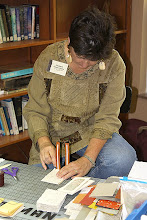Influenced again by the China Clay industry of Cornwall, UK, my newest abstracted handmade paper landscapes, which will be in the St. Louis biennial
Innovations in Textiles exhibition at the
Edwardsville Art Center later this month, incorporates 19th century sky tips, sun pans, pan kilns and mica drags as seen from the air, through the earth and across the moor
s. Our recent trip to Cornwall and a photograph of the China Clay workings near Hensbarrow Downs (below) was inspiration for my latest artwork.
 |
| China Clay workings around Hensbarrow Downs, showing large sky tips, pan kilns and mica drags. |
In Cornwall, water has always been used to wash the kaolin from the soft granite. In the early days of the 19th century, removing the clay was very labor intensive and clay was washed into shallow pits. As technology developed, the waste quartz and mica were removed and the clay was dried in sun pans until the first pan kilns were built in 1845. Waste materials from the pits were transported by tram to spoil tips on the surface which gleamed in the sunlight like pyramids. Especially interesting to me is the history of the women clay workers. According to the brochure of the China Clay Museum near St. Austell:
Women were employed in the China Clay industry to carry out a particular task before pan kilns dried all the clay at each clay works. At first the clay was left to dry in a shallow tank called a "sun pan". The sun pan was lined with sand and as the clay hardened it was cut blocks were stacked in the air dry, a small open-sided structure where the clay was dried by the circulation of air through the building. The women were then employed at a daily rate to scrape clean the bottom and sides of each block. Two or three tons of day could be cleared in a day, and the women were paid about a shilling a day.
For more information about mining in Cornwall in the 19th century, check out this link which is a copy of the printed brochure from the China Clay Museum in Cornwall.

